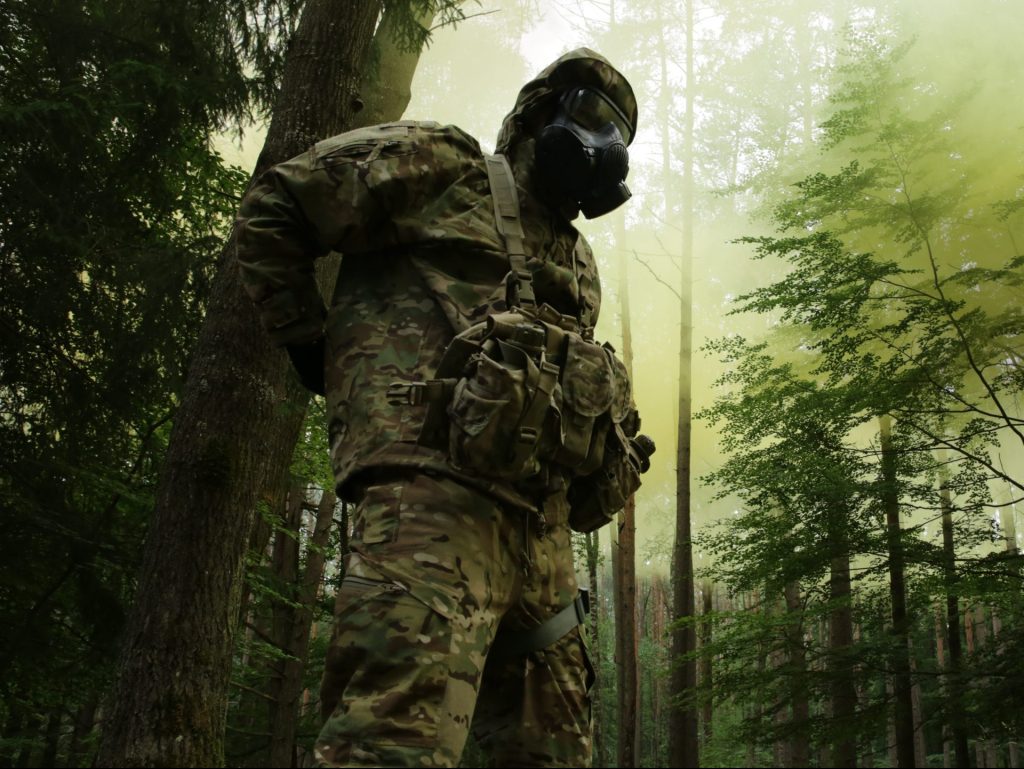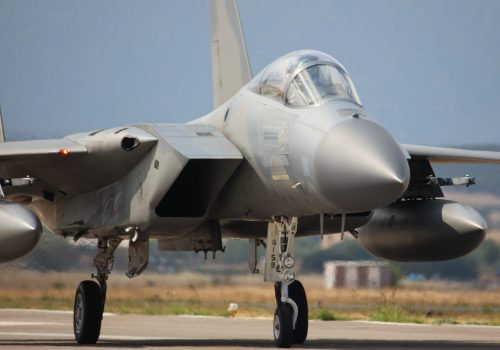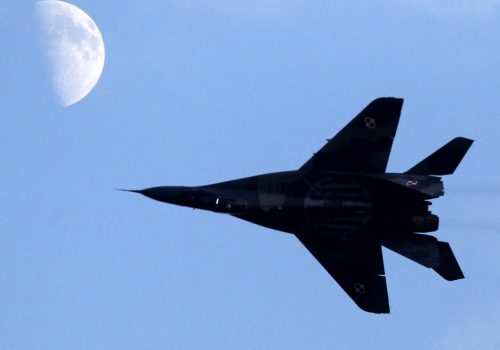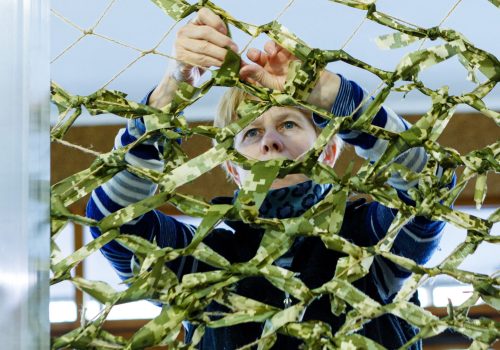Amid growing speculation that Russia could employ chemical weapons in its war against Ukraine, NATO has collectively voiced its concern over such an escalation, saying it would “result in severe consequences.” The Alliance has also pledged to increase protective equipment for Ukraine while enhancing its readiness against any chemical, biological, radiological, and nuclear threats.
But how serious are the chemical and biological threats, and what exactly should NATO do to prepare?
The West is right to be concerned. Russia used nerve agents from the Novichok family of chemical weapons to target a former Russian intelligence officer, Sergei Skripal, and his daughter in the United Kingdom in 2018 and prominent opposition leader Alexei Navalny in Siberia in 2020. These attacks—predictably denied by Moscow—contradicted Russia’s claims that it destroyed the remnants of its chemical weapons program in 2017.
Russia has also propped up a Syrian regime that repeatedly used chemical weapons in its brutal civil war, as well as wielded its United Nations Security Council (UNSC) veto to shield Syrian President Bashar al-Assad and other responsible individuals in his government from justice. This impunity has set a dangerous precedent that could tempt Russia: If Damascus could get away with it, why can’t Moscow?
Meanwhile, Russia has also circulated disinformation about a purported biological weapons program in Ukraine backed by the United States—and even brought these false claims to the UNSC in March (they were swiftly dismissed). Related conspiracy theories have taken off on platforms such as Twitter and Telegram, received air time on US television channels, and were parroted by China. These allegations could set the pretext for a false-flag attack involving chemical weapons that Russia could use to expand its invasion or justify additional military action against Ukraine.
While sanctions have destabilized the Russian economy and shrunk the resources available for President Vladimir Putin’s war efforts, he likely already has what he needs to mount chemical attacks in Ukraine.
Moves, not just messaging
To preempt Russia’s use of chemical or biological weapons, the United States and its NATO allies must publicly demonstrate that the West takes this threat seriously and are prepared to respond.
In the past few weeks, White House Press Secretary Jen Psaki and Department of Defense spokesperson John Kirby have done just that, raising these issues on social media and during press conferences. NATO Secretary General Jens Stoltenberg made clear that any use of chemical or biological weapons would violate international law, while citing worries that the effects of biological or chemical agents would be felt in Ukraine’s neighboring countries (several of which are NATO members).
And just as it “pre-bunked” potential Russian false-flag operations before the invasion began, the United States should also aggressively and proactively debunk Russian misinformation about chemical and biological weapons.
Additionally, NATO should update its strategy for countering chemical, biological, radiological, and nuclear weapons. The Comprehensive, Strategic-Level Policy for Preventing the Proliferation of Weapons of Mass Destruction (WMD) and Defending Against Chemical, Biological, Radiological and Nuclear (CBRN) Threats was last updated in 2009 and does not account for the numerous developments in the international security environment. For example, the document references cooperation with Russia as a key element to curbing WMD proliferation, which is clearly untenable today. Russia has also shown its willingness to flout international norms and use CBRN weapons—so NATO’s new policy must place a corresponding emphasis on the ability to defend against such weapons.
The Alliance is set to release its next Strategic Concept at the Madrid Summit in June; by referencing a more relevant CBRN policy in that document, NATO would send a clear message to Moscow that CBRN threats remain top of mind.
Messaging, however, is not enough. Words must be backed up by tangible actions. NATO has sent forty thousand troops to allied nations close to Ukraine; they should be reinforced with CBRN defense capabilities. NATO’s top military commander, US Air Force General Tod Wolters, has already activated the Alliance’s Combined Joint CBRN Defense Task Force, putting it on alert in case it is required to deploy. It can respond to a chemical, biological, radiological, or nuclear attack with reconnaissance, sampling, protection, and decontamination capabilities, among others. Deploying this task force to support other military reinforcements along its eastern flank would demonstrate NATO’s practical preparedness to respond to contingencies that could involve CBRN weapons used by Russia.
Finally, the US Department of Defense should sustain its support of Ukraine via the Cooperative Threat Reduction (CTR) program, which was established after the fall of the Soviet Union to secure and destroy Soviet WMD materials. The CTR program has a long history of working with Ukrainian officials to reduce WMD threats by destroying nuclear delivery systems and improving biological safety and security. US efforts can benefit from CTR’s long-standing relationships with Ukrainian government partners to quickly deliver additional supplies and equipment, which could include supporting other US government efforts to provide Ukraine with protective gear in case of a chemical attack.
Through coordinated efforts that incorporate public messaging and tangible action, NATO might have a chance to dissuade Russia from escalating the conflict in Ukraine to chemical warfare. But to do that, Moscow needs to know that the use of chemical weapons will not help its ill-fated invasion and will not be tolerated.
Natasha Lander Finch is a nonresident senior fellow at the Scowcroft Center’s Transatlantic Security Initiative.
Further reading
Fri, Mar 18, 2022
A no-fly zone over Ukraine? The case for NATO doing it.
New Atlanticist By Richard D. Hooker, Jr.
The West stands at the crossroads. It's time to act by establishing a no-fly zone over Ukraine.
Fri, Mar 18, 2022
A no-fly zone over Ukraine? The case against NATO doing it.
New Atlanticist By Kelly A. Grieco
Intervening beyond providing weapons to Ukraine's military and food to the Ukrainian population would only make the nightmare worse.
Fri, Mar 18, 2022
A no-fly zone over Ukraine? The case for NATO helping in other ways.
New Atlanticist By
There’s plenty NATO member states can do to protect civilians on the ground short of shooting down Russian aircraft.
Image: U.S Army Pfc. Seth Gordon, a CH-47 Helicopter Repairer assigned to Bravo Company, 1-214 General Support Aviation Battalion, 12th Combat Aviation Brigade, participates in the Soldier Of The Year Competition held at the Joint Multinational Readiness Center, Hohenfels, Germany on June 17, 2020. US Army photo by PFC Zachary Bouvier/DVIDS.



